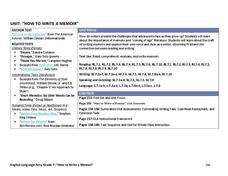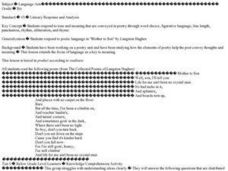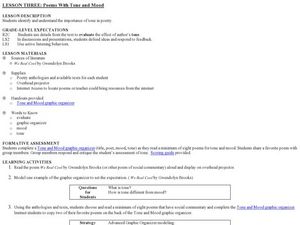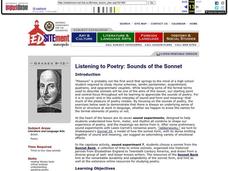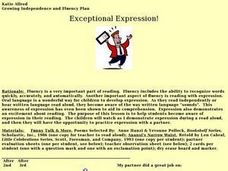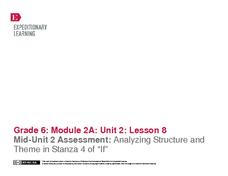Novelinks
Touching Spirit Bear: Directed Thinking Activity
Can you guess what is going to happen in a story just by looking at the cover? Readers engage in a directed-reading activity in which they preview the text from Touching Spirit Bear by Ben Mikaelsen, read to find an answer, and re-read...
EngageNY
Grade 10 ELA Module 1: Unit 1, Lesson 7
Can three works of literature work together to establish and develop a common central idea? Put your thoughts into writing with a final assessment focused on a unit-long analysis of Christopher Marlowe's "The Passionate Shepard to His...
Louisiana Department of Education
How to Write a Memoir
Who are we and what shapes our identities? Seventh graders work to answer this question as they learn how to write a memoir. Full of non-print resources and supplemental texts that range from fiction to non-fiction, scholars write their...
EngageNY
End of Unit Assessment: On-Demand Informational Paragraph About How the Poison Dart Frog Survives
A final assessment marks the end of a unit that takes a close look at a variety of informational texts all about frogs. A graphic organizer aides scholars in planning an accordion paragraph using their recorder forms from previous...
Curated OER
Poetry language in "Mother to Son"
Sixth graders respond to poetry. For this poetry lesson, 6th graders read the "Mother to Son" by Langston Hughes and they are split into 3 groups for below, at and above grade level. Each group has a different activity to show...
Curated OER
You Are What You Read
Sixth graders select a prose, poetry, or nonfiction excerpt from a book of their choice and share it by reading aloud to their classmates, who identify the genre and respond to related questions in their journals.
Curated OER
Acrostic Poems: What's In a Name?
Students find words that begin with the letters in their own names, using a variety of sources including word banks and online dictionaries. They create an acrostic poem. Pupils revise poems as needed, for meaning and conventions. ...
Curated OER
Number Writing Poems
Students read the short poem for each number to help them with number formation. In this numbers lesson plan, students follow directions of the poems.
Curated OER
Flying To Fluency
Students increase their reading fluency through the use of various strategies. After reviewing decoding and rereading strategies, students complete an initial read of a novel text. Working with a partner, they read complete a timed...
Curated OER
Discovering Angel Island: The Story Behind the Poems
Students watch a video titled Discovering Angel Island: The Story Behind the Poems about immigrants that came through Angel Island. In this Angel Island lesson plan, students respond with a journal entry.
Curated OER
Poems with Tone and Mood
Learners examine the use of tone in poetry. In this literature lesson, students read "We Real Cool," by Gwendolyn Brooks and use the provided graphic organizer to chart the poem's tone and mood.
Curated OER
Reading About the Journey: The Odyssey
Young scholars practice their reading skills. In this reading fluency and comprehension lesson, students read instructor-selected passages from The Odyssey following the provided steps for the reading class activity that requires them to...
Curated OER
Shh! It's Reading Time!
Students observe and demonstrate how to read silently. They discuss the "Cross-Checking" strategy, select a book for independent reading, and demonstrate silent reading. Students write a summary of what they have read in their reading...
Curated OER
A Journey To Japan Through Poetry
Third graders gain an appreciation for writing, analyzing, reading and listening to poetry, viewing poems as a motivation for studying Japanese culture and tradition. They study and create their own haiku and tanka poems with illustrations.
Curated OER
Listening to Poetry: Sounds of the Sonnet
Students experience and enjoy the sounds of poetry. They erform sound experiments with sonnets and closely read and analyze a sonnet by Shakespeare. Students write an analysis of how sound affects meaning in a sonnet chosen from the...
Curated OER
"Leap, plashless": Emily Dickinson & Poetic Imagination
Students examine different poems from Emily Dickinson. They practice listening for meter in the poems and make connections between the texts. They also practice their own creative writing skills.
Curated OER
Breaking up a Poem
Seventh graders break down the barriers in reading, speaking, listening, writing and understanding poetry. As a whole group, they establish their own criteria for line breaks by discussing questions and taking notes on a PowerPoint...
Curated OER
Exceptional Expression!
Young elementary learners develop expression while reading. They listen as the teacher demonstrates expression when reading aloud. Individual learners read with a partner and practice using expression in their reading. When their partner...
Curated OER
Picture It!
Students participate in visualization exercises as a reading comprehension strategy. As the teacher reads a poem, the students visualize the setting, then read the poem "Daddy's Making Dinner" and create a drawing of what they visualize...
Curated OER
Producing Beats
Turn your classroom into a music studio as groups work together to determine why music sounds different when performed live versus a recording. After listening to some different music, each group picks a poem, creates a recording, and...
Great Books Foundation
Shared Inquiry Lesson Plan for “The New Colossus”
Two is better than one. Scholars use shared inquiry and discuss their ideas with one another to better interpret Emma Lazerus' poem "The New Colossus." They work through pre-reading, reading, questioning, and rereading activities before...
Classroom Adventures Program
Creating Characters
Examine character in depth. Over the course of these six lessons, learners explore their own character traits, determine the traits of characters in the books they read, practice comparing and contrasting, and collaborate in small groups...
EngageNY
Analyzing Structure and Theme in Stanza 4 of “If”
Here is a lesson that provides scholars with two opportunities to stretch their compare-and-contrast muscles. First, learners compare and contrast their experience reading the fourth stanza of If by Rudyard Kipling to listening to the...
EngageNY
Grade 11 ELA Module 2: Unit 2, Lesson 11
In Audre Lorde's poem "From the House of Yemanjá," the speaker describes her mother's two faces, adding a whole new meaning to the phrase "two-faced." Pupils first read the final stanza of the contemporary poem. With a Quick Write, they...




